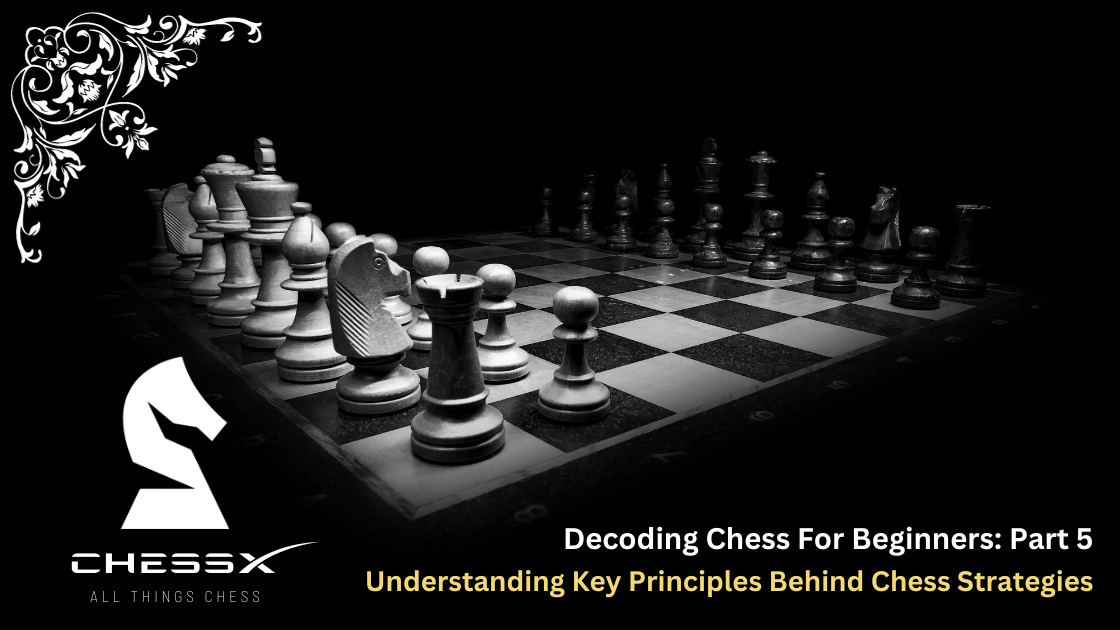Decoding Chess for Beginners: Understanding Key Principles Behind Chess Strategies

In the fifth installment of the Chess for Beginners series, we delve into the essential key principles behind chess strategies.To gain the most from this discussion, we encourage you to read the complete blog.
If you are fortunate enough, all you would need is a strong opening and an opponent who doesn't see through your opening to finish the game quickly. For the less fortunate, they will have to play until the end.
If you aspire to conclude the game victoriously, you need a proper strategy to support your goal. In this blog, We have identified the key principles upon which various chess strategies are devised.
There are four key principles based on which all chess strategies are developed. Other strategies for each piece will be detailed in the following text. However, the four to focus on for now are:
(i) Piece quality and development
(ii) Center control
(iii) King safety
(iv) Pawn formation.
Let us now look at each of these principles in detail:
Piece Quality and Development
As you may be aware, there are different kinds of pieces in the game of chess, and each piece has its own value. The various pieces, along with their values, are as follows:
- Queen – 9
- Rook – 5
- Bishop – 3
- Knight – 3
- Pawn – 1
However, these values are not static because every piece's true value continuously changes as the game develops. Piece development refers to the ability of the piece to move effectively and complement the other pieces on the board, which can increase its true value.
The attributes that determine the flexibility of a piece are as follows:
(i) Flexibility: Flexibility is the ability of a piece to change its role. In other words, it is its ability to change from being a passive piece to an active piece. Usually, pieces situated near the center of the board are more flexible than those at the corners.
(ii) Stability: A piece is valuable as long as it is on the board. A queen is of no value if it is already off the board. Hence, ensure that all strong pieces are well defended. Never put them in vulnerable positions or leave them unprotected.
(iii) Mobility: No piece can contribute if it does not have enough space to move, not even the queen. Ensure that there is always enough space for your pieces to move.
(iv) Suitability: Understand the capacity of every piece. Some pieces are well-suited for aggressive attacks, while others excel in defensive strategies. Understand the suitability of each piece before incorporating them into your strategy.
Some pointers for improving piece development are as follows:
Maintain Space Advantage:
Don't relinquish your space advantage. Space advantage, also known as territorial advantage, involves controlling the majority of squares on the board. As you advance your pawns, you create territory for yourself. The squares behind your line of pawns are secure territory during the early stages, positioning your other pieces behind them for movement and advancement. Greater space advantage allows you to move your pieces effectively and realize their fullest potential.
Be Aggressive and Give Threats:
Avoid refraining from giving threats. When you stop presenting threats, you indirectly provide your opponent with time to contemplate and respond. Attacking directs your opponent's attention, causing them to shift focus from their plans to defense. This aligns with the saying, "The best defense is a good offense."
Stay Resolute Against Enemy Threats:
Do not be distracted or dissuaded by enemy threats. Yielding to the pressure imposed by your opponent may lead to fatal errors. Stay focused, and your defeat will be less likely.
Activate All Pieces:
Don't allow any piece to remain inactive. Advance and use your pieces effectively. Beginners often leave major pieces in passive positions. Memorize various openings and understand how they can be used not only to advance pawns but also the army behind them.
Consider Alternative Moves:
Recognize that there can be more than one good move. Analyze every move in detail before proceeding. Recording your games allows you to review whether an alternative move might have resulted in more favorable outcomes.
Move Pieces Strategically Across the Board:
Move your pieces as much as possible and aim to reach the other half of the board. Simultaneously, prevent the opponent's pieces from entering your half.
Deny Good Squares to Your Opponent:
Never give your opponent the opportunity to place their pieces on favorable squares. Prophylaxis, meaning 'suffocation' in medical terminology, involves denying your opponent the chance to position pieces strategically. Aaron Nimzovich of Russia introduced this technique in the early 1900s, initially facing mockery from fellow players. However, his success in games quickly earned him recognition as one of the world's top five players. Nowadays, top chess players universally employ this strategic concept.

In the above example, the White player here has made great use of prophylaxis positioning, which most effectively draws a frustrated emotional response from the black player.
We can see white’s superior pawn and knight formation, along with his f2 and d2, immobilizes black’s knight advancement at b3, d3, d4, e3, e4, g3 and h4. Black’s queen is also restricted from white territory all along the open lane of diagonal light-colored squares it so hopes to capitalize upon.
o access the entire blog, subscribe to our premium plans today and elevate your chess game to the next level. Get ChessX for all things chess.